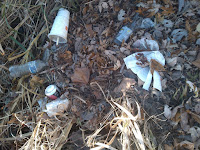A single wispy white feather, backlit by the morning sun, caught on a slender stem near the ground. A few crystals of frost glitter along the threadlike barbs. It's a fairly large feather, so I assume from a fairly large bird. Maybe it fluttered to the ground from one of the geese winging overhead?
My brain catalogs it as a down feather, the fluffy white feathers close to a bird's body, under the smooth outer feathers, that help insulate it from the cold outside. A bit of research with the Cornell Lab's Bird Academy introduces me to the seven different types of feathers: wing (or remiges), tail (rectrices), contour, semiplume, down, filoplume, and bristle.
The first three--wing, tail, and contour feathers--are those we are most familiar with, the feathers we see immediately when looking at a bird. They are used for locomotion and protection from the elements, as well as communication (for example, courtship and territorial displays). They have a central shaft, or rachis, flanked by a series of barbs that are zipped together by interlocking barbules and tiny hooks called barbicels.
Down and semiplume feathers trap heat below the surface feathers; these feathers lack the hooked barbicels so they don't zip together as neatly as the surface feathers. Semiplume feathers have a central rachis, which is reduced or absent in a down feather--so my feather here appears to be a semiplume.
The other two types of feathers are not easily visible: filoplumes, whiskery feathers with a tuft of barbs at the end, thought to help birds feel or sense what is going on feather-wise (since the feathers themselves don't have nerves in them), and bristles, basically just a threadlike rachis without barbs along most of its length, often found near a bird's eyes or beaks and also thought to provide additional sensory information.
Watching birds preen, carefully drawing a long feather through its bill to zip the barbs together cleanly, I marvel at the efficient and tidy bodily covering, so different from my own lackluster human coat, with its messy mop of hair that snarls and curls and tangles, above a pale and sensitive pink skin that requires a different protective coating for essentially every different condition: winter coats, rain coats, jackets, sweaters, sunscreens, hats.
How convenient it would be to have just a single covering for every condition and every season! When cold, puff up and allow those downy feathers to capture heat close to your body. Rain runs off the sleek, overlapping arrangement of feathers, while feathers shade the tender skin beneath from the sun's damaging rays. I imagine the meditative calm of arranging each feather so it lies perfectly in place, or maybe the irritating discomfort of a broken or misaligned feather.
I wonder what the birds think, seeing us in our ever-changing array of adornments through the seasons, unable to face the elements without all these accoutrements, unable to compare to the marvel of a single feather.
Sources/Additional Reading:



